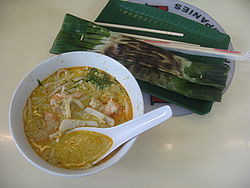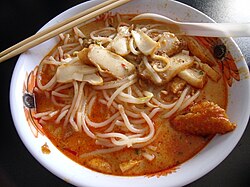Laksa is a popular spicy noodle soup from the Peranakan culture, which is a merger of Chinese and Malay elements found in Malaysia and Singapore, and to a lesser extent, Indonesia.
There are two basic types of laksa: curry laksa and asam laksa. Curry laksa is a coconut curry soup with noodles, while asam laksa is a sour fish soup with noodles. Thick rice noodles also known as laksa noodles are most commonly used, although thin rice vermicelli (bee hoon or mee hoon) are also common and some variants use other types
Curry laksa
Curry laksa (in many places referred to simply as “laksa”) is a
coconut-based curry soup. The main ingredients for most versions of
curry laksa include bean curd puffs, fish sticks, shrimp and cockles. Some vendors may sell chicken laksa. Laksa is commonly served with a spoonful of sambal chilli paste and garnished with Vietnamese coriander, or laksa leaf, which is known in Malay as daun kesum.
This is usually known as Curry Mee in Penang rather than curry laksa, due to the different kind of noodles used (yellow mee or bee hoon, as opposed to the thick white laksa noodles). Curry Mee in Penang uses congealed pork blood, a delicacy to the Malaysian Chinese community. Two of the well known places to try curry mee is at Lorong Seratus Tahun and Chulia Street.[citation needed]
The term "Curry laksa" is more commonly used in Kuala Lumpur or Singapore. Laksa is popular in Singapore and Malaysia, as are laksa yong tau foo, lobster laksa, and even plain laksa, with just noodles and gravy.
Variants of curry laksa include:
- Laksa lemak, also known as nyonya laksa (Malay: Laksa nyonya), is a type of laksa with a rich coconut gravy. Lemak is a culinary description in the Malay language which specifically refers to the presence of coconut milk which adds a distinctive richness to a dish. As the name implies, it is made with a rich, slightly sweet and strongly spiced coconut gravy. Laksa lemak is usually made with a fish-based gravy (with vegetarian food stalls omitting fish) and is heavily influenced by Thai laksa (Malay: Laksa Thai), perhaps to the point that one could say they are one and the same.
- Laksam, a speciality of the Northeastern Malaysian states of Kelantan, Terengganu and Kedah, is made with very thick flat white rice flour noodles in a rich, full-bodied white gravy of boiled fish and coconut milk. Though usually made of fish flesh, it is sometimes made with eels. Traditionally laksam is eaten with hands rather than with eating utensils due to the gravy's thick consistency
- Katong laksa (Malay: Laksa Katong) is a variant of laksa lemak from the Katong area of Singapore.
In Katong laksa, the noodles are normally cut up into smaller pieces so
that the entire dish can be eaten with a spoon alone (that is, without
chopsticks or a fork). Katong laksa is a strong contender for the
heavily competed title of Singapore's national dish.
Asam laksa
Asam laksa is a sour, fish-based soup. It is listed at number 7 on World's 50 most delicious foods complied by CNN Go in 2011.Asam (or asam jawa) is the Malay word for tamarind, which is commonly used to give the stock its sour flavor. It is also common to use asam keping (also known as asam gelugor), dried slices of sour mangosteen, for added sourness. The modern Malay spelling is asam, though the spelling assam is still frequently used.The main ingredients for asam laksa include shredded fish, normally kembung fish or mackerel, and finely sliced vegetables including cucumber, onions, red chillies, pineapple, lettuce, common mint, "daun kesum" (Vietnamese mint or laksa mint) and pink bunga kantan (ginger buds). Asam laksa is normally served with either thick rice noodles or thin rice noodles. And topped off with "petis udang" or "hae ko" , a thick sweet prawn.
Variants of asam laksa include:
- Penang laksa (Malay: Laksa Pulau Pinang), also known as asam laksa from the Malay for tamarind, comes from the Malaysian island of Penang. It is made with mackerel (ikan kembung) soup and its main distinguishing feature is the asam or tamarind which gives the soup a sour taste. The fish is poached and then flaked. Other ingredients that give Penang laksa its distinctive flavour include lemongrass, galangal (lengkuas) and chilli. Typical garnishes include mint, pineapple slices, thinly sliced onion, hε-ko, a thick sweet prawn paste and use of torch ginger flower. This, and not 'curry mee' is the usual 'laksa' one gets in Penang.
- Perlis laksa (Malay: Laksa Perlis) is similar to Penang Laksa but differs in garnishing used such as catfish and eel fish. The famous Perlis laksa can be found in Kuala Perlis.
- Kedah laksa (Malay: Laksa Kedah) is very similar to Penang laksa and only differs in the garnishing used. Sliced boiled eggs are usually added to the dish. Kedah laksa used rice to make a laksa noodle. The famous laksa in Kedah is Laksa Telok Kechai.
- Ipoh laksa (Malay: Laksa Ipoh), from the Malaysian city of Ipoh, is similar to Penang laksa but has a more sour (rather than sweet) taste, and contains prawn paste.
- Kuala Kangsar Laksa (Malay: Laksa Kuala Kangsar), made of wheat flour (usually hand made). The soup is rather lighter than the common laksa taste and so much different from Ipoh Laksa in shape, taste and smell. The local municipal council even built a complex called "Kompleks Cendol dan Laksa" near the river bank of the Perak River. It is the main attraction for tourists in Kuala Kangsar
Here is the receipe to prepare laksa





No comments:
Post a Comment